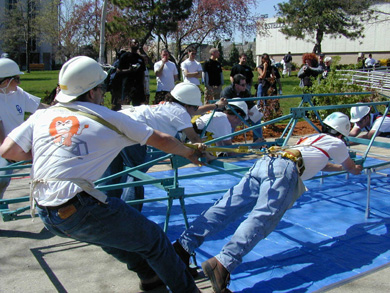
|
|
As he helps construct the bridge, team co-leader Daniel Greenstein, SEAS'00, is held in a harness over blue tarps that simulate water.
|
Setting out with imagination, engineering skill and relentless determination, the members of the Columbia Steel Bridge Team 2000 have realized their dreams of producing something tangible. Very tangible.
The team constructed a 22-foot steel bridge strong enough to support more than 2,500 pounds-a project that won second place in the Metro region of the National Student Steel Bridge Competition and qualified the Columbia engineers for the national championships at Texas A&M on May 20.
Overall, the team placed second behind Dalhousie University of Halifax, Nova Scotia, and ahead of Cooper Union and the New Jersey Institute of Technology. Rutgers and Steven's Tech were entered in the competition, but withdrew because the teams believed their bridges were unprepared for the rigorous test. Columbia's second place finish qualifies them for competition in the national championship.
"The triumph of this project is that we started with very little team knowledge," said Daniel Greenstein, SEAS'00, the team's co-leader along with Ben Aakre, SEAS'00. The venture, Aakre said, was a combination of experiment and exploration. "There was excitement at every step. There were milestones all along the way."

|
|
Members of the Columbia Steel Bridge Team 2000 are students in the Fu Foundation School of Engineering and Applied Science.
|
Much of the competition depended on the bridge's "constructability," or ability to be assembled as quickly as possible. Students started with separate parts and had to erect their bridge around a "dead-zone" of blue carpet that simulated water. To connect parts in the bridge's center, team members extended their reach with the use of a harness system. A harnessed team member leaned out over the dead-zone while a teammate, holding a tether attached to the back of the harness, leaned in the opposite direction and acted as a counterweight. Through intense practice that included constructing and deconstructing their bridge more than 15 times, the Columbia team cut their assembly time down from 1 1/2 hours to a competition time of 26 minutes.
Once a bridge was erected in competition, judges tested it for strength with 2,500 pounds of weight. The steel beams were allowed to deflect (or bend) vertically only within two inches and horizontally within one-half inch. The Columbia bridge was well within both measurements, placing first in both stiffness and economical use of materials.
One of the biggest challenges the students faced was finding a steel supplier that would provide the steel in the small dimensions that the bridge required. Fortunately, after many phone calls, they contacted Strocchia Iron Works of Brooklyn, which agreed not only to provide them with the steel but, upon learning of the competition, donated it to the students for free.
"We got a lot of motivation from family and friends," Greenstein said, "but once we got the steel for free, there was a real feeling of commitment."
The construction of the bridge was performed entirely by students, although they did receive some assistance from generous faculty and employees around the University.
Most of the labor was done in the engineering department's Carlton Lab, located in the basement of the Mudd Building. One night, after his own shift on campus had ended, University welder Denny Walker provided the students with a crash course in welding technique. Le-Ping Chen, lab manager, and Johny Manchery, senior lab technician, showed students how to correctly operate a steel grinder, steel drill and band-saw. Civil Engineering professor Christian Meyer drew a structural design for beam connections that the students used as a model. Greenstein noted the importance of this model. "In any structure, it all comes down to the connection," he said. "When two pieces come together, that's when the complexity arises."
Aakre conceived of the bridge's structure with efficiency in mind. "I wanted to design something that would be easiest to construct," he said, noting the plan required "a lot of long nights spent trying to figure it out."
While Aakre was responsible for the bridge's design, Greenstein brought a fervent desire to succeed and a knack for leadership. Together, they assembled the skilled team of more than 15 senior engineering students and structured a weekly timetable for work that was followed over several months right through to the bridge's completion.
"You develop a feeling about it," said team member Alex Usdan, SEAS'00, noting that the experience was an on-the-job education. "You learn how to build something structure by structure."
With graduation fast approaching, the bridge engineers will soon be able to apply their experience towards other projects in the field. Usdan will work as a structural engineer for Severud Consultants, a building design company. Aakre plans to head west and enter the construction industry or possibly find work with a city engineer. Greenstein expressed his intention with certainty: "I want to build buildings in New York City."
|
